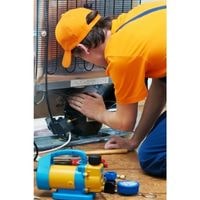Haier mini fridge not cooling. Here are some quick tips we thought you might find helpful.
Before anything else, make sure that your refrigerator is plugged into a working outlet; and be sure the unit is turned on to its cold setting before trying to fix the problem yourself next.
You will likely come across this issue if your cold setting isn’t quite strong enough so go ahead and test out various positions the thermostat has until you find one that helps with this particular issue.
If all of that fails, and you’re going nowhere fast, it may be time to get a repairman involved…the last course of action when dealing with Haier fridge problems!
Haier mini fridge not cooling

Here we will discuss some common issues and solutions for Haier mini fridge not cooling.
Condenser Coils Problem
It’s important to place the fridge in a well-ventilated area because if it is placed in a crowded space, the heat won’t be able to circulate as freely and this could cause the fridge to overheat.
However, that doesn’t mean you should place it next to an air conditioner because if you do this, hot air could re-enter the fridge.
And if there are too many coils inside or they are all dirty, they won’t be able to take out all the heat from the refrigerator properly and this will again result in things getting hotter than they should.
In some cases, the coils get covered with dust or anything else inside that won’t let them work efficiently.
This is why one has to ensure their coil is clean every once in a while, as opposed to being too close to anything that might block airflow.
Start Relay Defects
The start relay works with the start winding to power up the compressor. If a problem is identified with the start relay, it will cause issues with powering up the compressor.
The result may be that your fridge isn’t cold enough or won’t turn on altogether.
Use a multimeter to test for continuity between the run and start terminal sockets to determine if the start relay is defective. If there’s an issue with continuity, replace the start relay.
However, if the relay has a burned odor you may have other issues such as an electrical fire and this should be taken care of right away by an advanced professional!
Control Board Faults
The control board provides voltage to other components including the compressor and fan motors. If the control board is defective, this may prevent either or both of those things from working properly.
But in most cases, a control board issue can be traced back to another component since it’s uncommon for a control board to fail on its own.
When trying to diagnose which component is malfunctioning (which is the common scenario),
first test all of the more commonly defective components before you consider replacing the temperature control board if every other component seems to be working as intended.
Start Capacitor Faults
The compressor provides cooling for your refrigerator. The start capacitor boosts the power of the compressor when it needs to be restarted.
The compressor may not start if the start capacitor isn’t functioning properly, causing your refrigerator to remain inoperative. You can test the start capacitor with a multimeter to determine if it is defective.
If the start capacitor is available and in good health, attempt to replace it with a new one.
Problem With Fan Motor
If a refrigerator’s condenser fan is not working properly it may seem like the problem lies with the compressor or evaporator coils.
While these components may also be involved, the malfunction may actually lie within the condenser fan itself.
First, you should check to see if there are any obvious obstructions inhibiting the operation of this component.
If there aren’t any obvious problems, try manually turning the blades. It may need to be cleared away if it does not move freely.
To test the continuity of a non-moving blade remove one wire from each side and use a multimeter check between those two points for resistance (continuity).
Defective Thermostat
To test these components, allow them to warm up and rotate from low to high. Listen for an audible click, which tells you that they are working properly.
If you don’t hear the click, run a continuity test on the thermostat with a multimeter.
If you don’t find continuity, consider replacing it soon. Setting the thermostat too low can affect the functionality of the compressor.
Related Guides
